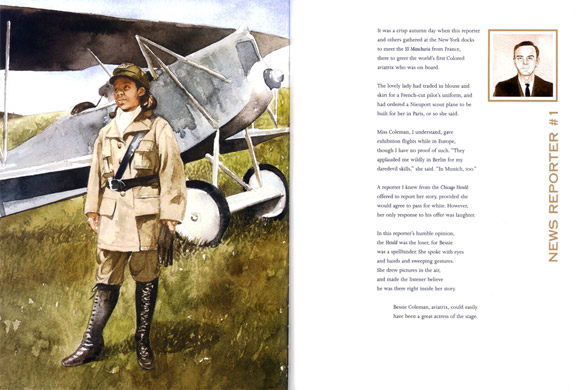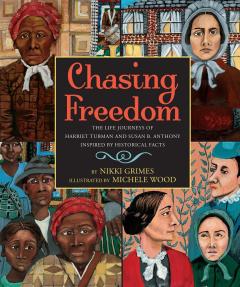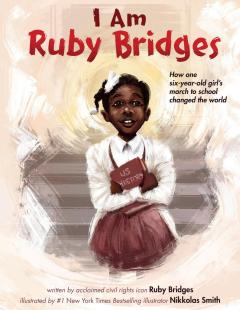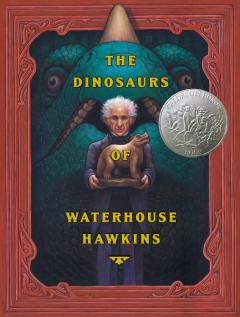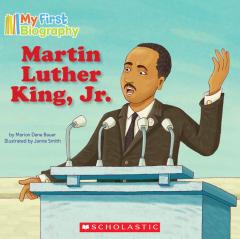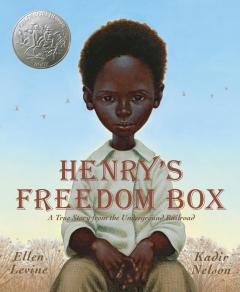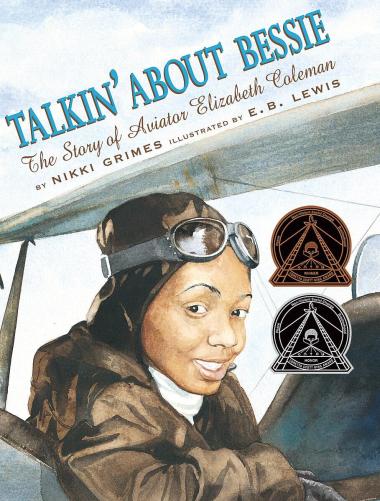
Talkin' About Bessie: The Story of Aviator Elizabeth Coleman
Illustrated By E. B. Lewis
Hardcover
About this book
Elizabeth "Bessie" Coleman was always being told what she could & couldn't do. In an era when Jim Crow laws and segregation were a way of life, it was not easy to survive. Bessie didn't let that stop her. Although she was only 11 when the Wright brothers took their historic flight, she vowed to become the first African -American female pilot. Her sturdy faith and determination helped her overcome obstacles of poverty, racism, and gender discrimination. Innovatively told through a series of monologues.Reviews
Grimes skillfully employs first-person testimonial verse to give young readers a fully realized portrait of African-American aviator Bessie Coleman. At Coleman's death, Grimes invites twenty individuals to a fictionalized wake and, in valedictory monologues, has each remember Bessie and the forces that shaped her life. Bessie's father tells about leaving the family when his daughter was "jus' a chile." Her mother recalls how she wanted Bessie to "first learn the wisdom of the Lawd, / and then, the wisdom of the world"; an older brother comments on her drive, how she "kept her focus fixed...to find a lifelong work of substance"; her flight instructor remembers how bravely Bessie flew a Nieuport 82 the day after witnessing one crash to the ground in flames; and a young fan reveres her idol: "I haven't made up my mind about being a pilot, / but Bessie made me believe I could be anything." E. B. Lewis personalizes the tributes (and a concluding testimonial from Bessie) with small photo-like, sepia-toned portraits of the speakers. Impressionistic watercolors on facing pages evoke each incident and often soften the harshness in Coleman's life. Taken as a whole, these illustrations portray a young woman yearning for and taking pride in that "lifelong work of substance." Although the assemblage of mourners is slightly contrived (would a field hand Coleman once worked alongside and a woman who once hired her to do laundry really be present at her wake?), their parts in Bessie's story are integral to her early life. Grimes separates fact from fiction through introductory comments on the historical period and the setting, concluding observations about Coleman, and source notes. Like Bessie, this tribute to her life soars.--Horn Book, January 1, 2003--starred reviewHistoric flights take the spotlight in two fall titles. Talkin' About Bessie: The Story of Aviator Elizabeth Coleman by Nikki Grimes, illus. by E.B. Lewis, recalls the life of the world's first licensed African-American female pilot through 20 eulogies, fictionalized perspectives based on actual people. "I remember that bone-chillin' January day in 1892/ when Bessie's first cry raised the roof/ off that dirt-floor cabin, back in Texas," Bessie's father, George Coleman, begins. Newspaper editor Robert Abbott tells of her enrollment in a French flight school ("No flight school/ in our color-minded nation/ would accept a woman, or a Negro"). Lewis's elegant inset portraits appear alongside the words of each speaker; full-bleed, full-page paintings illustrate dramatic moments in Coleman's life.--Publishers Weekly, November 25, 2002
In a volume that looks like a picture book and reads like a series of closely related poems, Grimes offers a many-sided portrait of the first African American aviatrix, Bessie Coleman. Following a brief introduction to Coleman's life, the story, couched in a fictional framework, opens in the parlor of a house in Chicago, where friends and relatives gather to mourn Bessie's death. Each spread features one person speaking about Bessie. A full-page watercolor faces a page with a small picture of the speaker and a free-verse reminiscence. The speakers range from mother to sister to flight instructor to news reporter, but teller by teller, the story moves chronologically and builds emotionally to the last entry, where Bessie speaks of the joy of flying. On the last page, Grimes comments on Coleman's life. Lewis' paintings, subdued in tone and color, reflect the spirit of the verse through telling details and sensitive, impressionistic portrayals. The verse reads aloud beautifully, making it a good choice for readers' theater. The book will also work well for reading aloud as the artwork shows up to good advantage from a distance. Although there have been other books about Coleman, this is a fine, original portrayal. --Booklist, November 15, 2002--starred review
"Brave Bessie Coleman," the first black woman in the world to earn a pilot's license, has been the subject of several recent picture book biographies: (Fly, Bessie, Fly, by Lynn Joseph, 1998; Fly High!, by Louise Borden and Mary Kay Kroeger, 2001; Nobody Owns the Sky, by Reeve Lindbergh, 1996). Grimes takes an unusual, fictionalized approach to portraying this determined, undaunted woman who made aviation history. She recreates the voices of 20 people who supposedly knew Bessie, expressing their point of view in a free-verse format. Each double spread has the person's monologue with his or her name or role running down the edge of the page with a cameo drawing like a photo at the top; opposite is a full-page illustration in Lewis's typical style that strikingly adds dimension and context to the times and the woman. From her father, who left the large family in Texas, to sisters to flight instructor to news reporter to young fan, the monologue device succeeds somewhat in piecing together a portrait of this woman who braved hardships of both poverty and prejudice. Her dream was to open an aviation school for African-Americans, but a plane crash in 1926 ended her life at age 34. The handsome design, large format, and beautiful artwork make this very attractive, but the lack of source notes or clarification of what's fictionalized--especially quotes--and the strange opening scene set at Bessie's wake as she speaks to her mother from her photo on the mantel, will leave many readers confused.--Kirkus Reviews, October 15, 2002
This fresh contribution to the spate of relatively recent titles about Coleman has a decidedly unique tone. Talkin' is a well-conceived, well-executed, handsomely illustrated, fictionalized account of the life of the first black female licensed pilot in the world (CIP places the book in the 600s). An introductory note puts the aviatrix in historical context, but neglects to explain some references (e.g., Jim Crow laws). The text consists of 21 poetic vignettes of Coleman delivered by "speakers" at a funeral parlor, all of whom have come to mourn the pilot who died at age 34 in a plane accident. Their reminiscences on stark white pages are illustrated with miniature portraits bordered in sepia, each one facing a full-page watercolor capturing a moment in the woman's life. Skillfully drawn and occasionally photographic in their realism, the pictures perfectly match each speaker's recollections. A concluding note states rather definitively in regard to her death: "The cause of the crash remains a mystery" despite some evidence to the contrary. No sources are listed. While fictional, this is a fine piece to use to set a tone or inspire more research into Coleman's life. It could also serve as an exceptional writing model for students. The concept, much like Marilyn Nelson's Carver: A Life in Poems (Front Street, 2001), is noteworthy.--School Library Journal, October1, 2002, starred review
